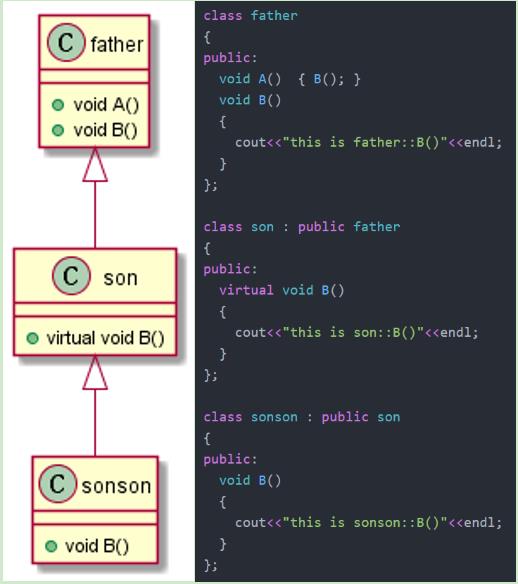间接调用虚函数
Posted windmissing
tags:
篇首语:本文由小常识网(cha138.com)小编为大家整理,主要介绍了间接调用虚函数相关的知识,希望对你有一定的参考价值。
运行结果是什么?

father *pf = new father();
pf->A();
pf->B();
delete pf;
father *ps = new son();
ps->A();
ps->B();
delete ps;
son *ps1 = new son();
ps1->A();
ps1->B();
delete ps1;
son *pss = new sonson();
pss->A();
pss->B();
delete pss;
运行结果
this is father::B()
this is father::B()
this is father::B()
this is father::B()
this is father::B()
this is son::B()
this is father::B()
this is sonson::B()
解释与结论
| id | 指针名 | 指针的类型 | 实际的类型 | 运行结果 | 解释 |
|---|---|---|---|---|---|
| 1 | pf | father | father | this is father::B() this is father::B() | |
| 2 | ps | father | son | this is father::B() this is father::B() | 由virtual关键字在子类可知此处不会有多态 |
| 3 | ps1 | son | son | this is father::B() this is son::B() | 此例中,指针的类型和对象的类型都是son,为什么最后调用的是fathher::B()? |
| 4 | pss | son | sonson | this is father::B() this is sonson::B() | 由virtual关键字在子类可知此处应该有多态效果,为什么最后调用的还是fathher::B()? |
解释:
在上面的测试用例中,ps1->A();和pss->A();的运行结果都是father::B()。它们都有一个共同的特点,就是指针通过A()去调用B()。
当程序通过A()调用B时,它已经处理father::A()的作用域里面了,因此此时它实际上已经不再通过ps1或者pss去访问B(),而是通过father::this。
father::this显然是father类型的指针,所以它会先去查看father::B()。它发现father::B()不是虚函数,也就不会去查vtable,而是直接调用father::B()了。这一部分的原理与virtual关键字在子类相同。
其它测试
完整代码
#include <iostream>
using namespace std;
class father
public:
void A() B();
void B()
cout<<"this is father::B()"<<endl;
;
class son : public father
public:
virtual void B()
cout<<"this is son::B()"<<endl;
;
class sonson : public son
public:
void B()
cout<<"this is sonson::B()"<<endl;
;
int main()
father *pf = new father();
pf->A();
pf->B();
delete pf;
father *ps = new son();
ps->A();
ps->B();
delete ps;
son *ps1 = new son();
ps1->A();
ps1->B();
delete ps1;
son *pss = new sonson();
pss->A();
pss->B();
delete pss;
return 0;
以上是关于间接调用虚函数的主要内容,如果未能解决你的问题,请参考以下文章